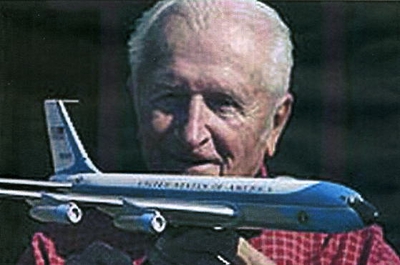Five hundred thousand rivets were used in the manufacture of the Douglas DC-3 airplane. The average size used in the manufacture was approximately 3-8 inches long, and if laid end-to-end, the rivets would cover a distance of 15,625 feet or more than three miles.
The lighting system of each DC-3 plane was sufficient to light an eight room house. More than 90 lights were used in each plane. 1,517 watts are required. To light an ordinary room in those days only 100 watts was required.
Approximately 6,000 men and women were employed in building a DC-3.
3,600 blueprints were turned out by the Engineering Department in the development of the DC-3. They covered approximately 28,000 square feet.
The total length of the control cables used on the DC-3 was over 2,850 feet, more than ½ mile.
Material used for sound insulation in the DC-3 and the DST "Sleeper" weighed 240 pounds. Blankets and mattresses weighed another 195 pounds.
3,900 feet of tubing, 8,000 feet of wire and approximately 13,300 square feet of sheet metal were used in the construction of each DC-3.
The heating and ventilation used in the DC-3 dispensed 1,000 cubic feet of air per minute on a warm day. As it took a little more than 15 hours to fly from Los Angeles to
New York , 900,000 cubic feet of air passed through the cabin or 60,000 to 75,000 pounds of air were utilized on the trip, depending on the altitude flown.
More than 120,000 BTUs were delivered to the cabin of a DC-3 on a cold day. On a flight to NY from LA, 1,800,000
BTUs were delivered during the 15 hours the plane was in the air. The boiler weighed 17 pounds and evaporated 15 gallons of water an hour. Approximately 225 gallons of water were evaporated from LA to NY. Only six quarts of water are carried in the heating system where it was continuously evaporated and condensed.
A radiator capable of heating air from 4 degrees F. to 200 degrees F. was installed in every DC-3. The air passed through the radiator at a speed of 3,000 feet a minute and since the radiator was only a foot long it took only 1/50 of a second to heat the air from 4 to 200 degrees. The radiator weighed 36 pounds.
Heating a DC-3 in the air was the equivalent of heating a building in a 200 mph wind at a 35 degree outside temperature .
Approximately 700,000 parts were used in the construction of the DC-3. This is exclusive of instruments and engine parts and exclusive also of the 500,000 rivets used on each plane.
The engines powering the DC-3 weighed 1,275 pounds each or a total of 2,550 pounds. This weight alone is a striking contrast to the payload available on some of the early airmail planes flown which was around 250 pounds.
At a cruise speed of 180 mph at 10,000 feet each engine developed 550 hp. Ninety-one gallons of fuel were used each hour giving approximately 2 miles per gallon










.JPG)
.JPG)



.JPG)
.JPG)
.JPG)

.JPG)
.JPG)









.JPG)





.JPG)

.JPG)
.JPG)
 4. Colonel James Swindal (SAM 26000)
4. Colonel James Swindal (SAM 26000)




.JPG)

.JPG)